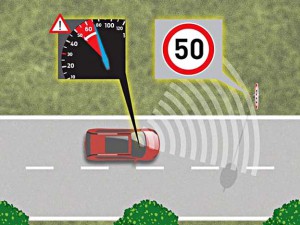“But officer…” If you’ve ever tried to explain your way out of a speeding ticket, claiming you didn’t know how fast you were going, or what the local limit was, you might want to check out the new Intelligent Speed Limiter that Ford is launching this year.
A number of vehicles now display the local speed limit on their navigation screens, some using cameras to ensure that the limit hasn’t changed since the navi database was created. The system being introduced in the next-generation Ford S-Max people-mover goes the next step, and actually controls the speed of the vehicle itself.
“Drivers are not always conscious of speeding and sometimes only becoming aware they were going too fast when they receive a fine in the mail or are pulled over by law enforcement,” notes Stefan Kappes, active safety supervisor, Ford of Europe. “Intelligent Speed Limiter can remove one of the stresses of driving, helping ensure customers remain within the legal speed limit.”
The Intelligent Speed Limiter might seem like a breakthrough but it simply builds on technology already used in a growing number of vehicles, including vision systems and Active Cruise Control. The latter allows a motorist to set a preferred speed and relax. It will automatically adjust to the pace of traffic and, on some models, even bring the vehicle to a complete stop in a traffic jam.
A number of new vehicles, meanwhile, use camera systems to watch out for potential collisions and to ensure a car doesn’t drift out of its lane. Some also watch for speed limit signs, flashing the correct number up on the navi screen or a Head-Up Display.
Ford combines these technologies together. The Limiter automatically sets the vehicle’s cruise control to the legal limit, adjusting speed when the limit changes during a drive.
To smooth out the ride, Ford says the system cuts gas flow rather than hitting the brakes.
The decision to launch the system in Europe first was for several reasons. The Continent uses more uniform traffic sign shapes, for one thing. But European motorists also face generally lower speed limits and stricter enforcement – including an estimated 35,000 traffic cameras.
The maker says it may expand the use of the Intelligent Speed Limiter to other vehicles besides the seven-passenger S-Max. And Ford may also offer it in other markets, including Asia and possibly the U.S. where enforcement has been increasing – even though many states and cities have begun to cut back on the use of speed and red light cameras.
(Congressman pushes for nationwide ban on traffic cameras. Click Here to learn why.)
Volvo is expected to launch a similar system in its new XC90 sport-ute, and similar technology could become more commonplace in the years ahead. Indeed, the autonomous vehicles we’ll start to see hitting the road in the coming years will, by definition, need to be capable of automatically detecting and maintaining local speed limits.
(Click Here for details about Delphi’s new automated driving system.)
(The little Google Car pilot vehicles the Silicon Valley tech giant is planning to fleet test actually will have the ability to go as much as 5 mph over the speed limit, Google officials explain, to maintain the flow of traffic.)
(To see more about Volvo’s plans to put 100 autonomous vehicles on the road by 2017, Click Here.)
While the Intelligent Speed Limiter is the first system specifically designed to automatically obey speed limits, Ford already offers its MyKey system on a number of vehicles. The smart key can be given to teen drivers to limit how fast they are allowed to drive. Chevrolet is introducing a similar system on its 2016 Malibu sedan.


This story is a day or two late (here) and it has been discussed on many forums. There are a number of views on this system including the potential accident issues when the throttle response is inappropriate unless you got to WOT, if your currently at or above the speed limit. There are also the issues with getting a ticket when a speed zone changes and people expect the car to automatically correct and it doesn’t. We’ve all seen speed signs that have been altered by kids with spray paint, etc. so that’s another potential issue. Nav system stored roadway speeds are based on when the road was mapped and/or the latest Nav software update so it could be wrong, etc.
I think Ford is going to be surprised at the push back on this system once it’s in service.
I can’t imagine a system that would be more disliked than this. Here in Georgia it will earn you a ticket if you’re only going the speed limit and cars are lined up behind you in the passing lane on the Interstate.
I predict they’ll sell a handful and then drop it entirely. Adaptive cruise makes a heck of a lot more sense.